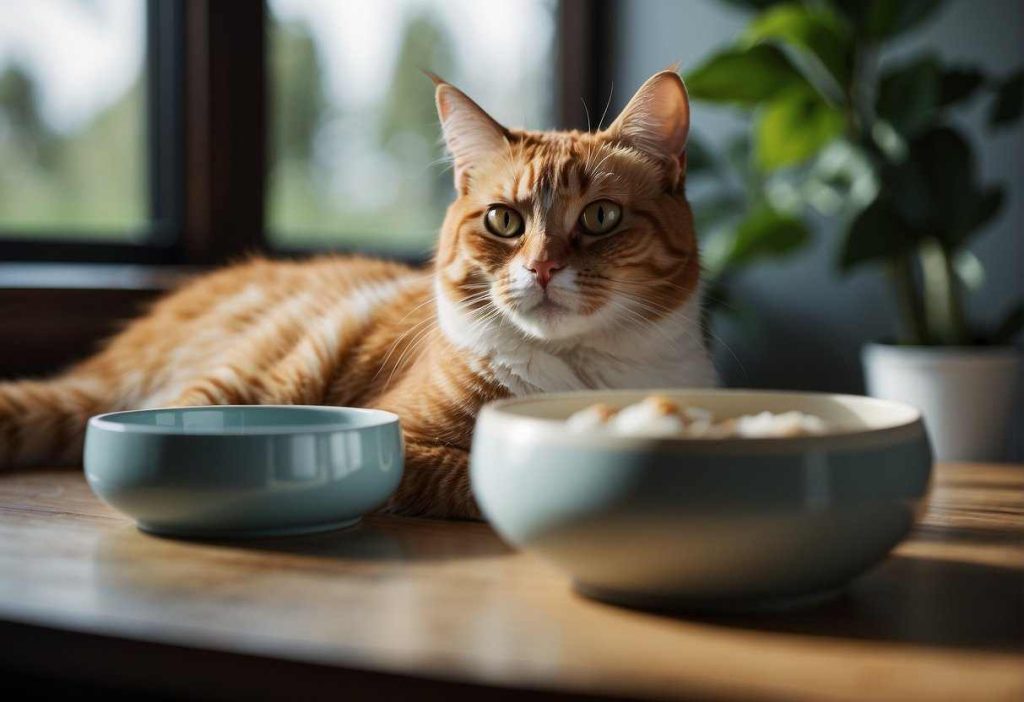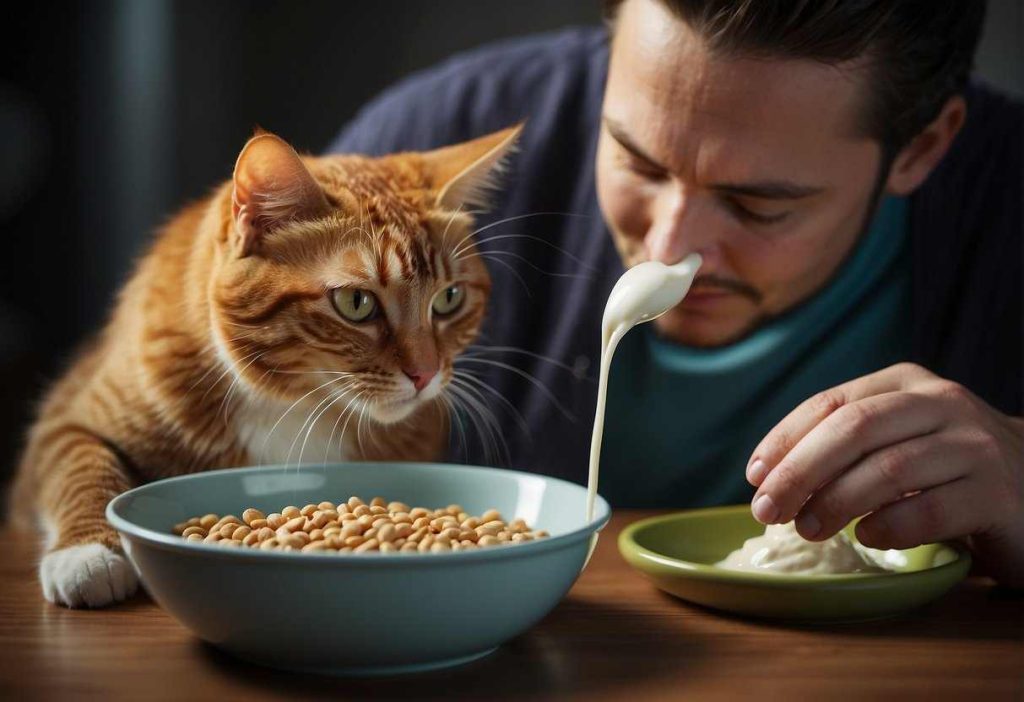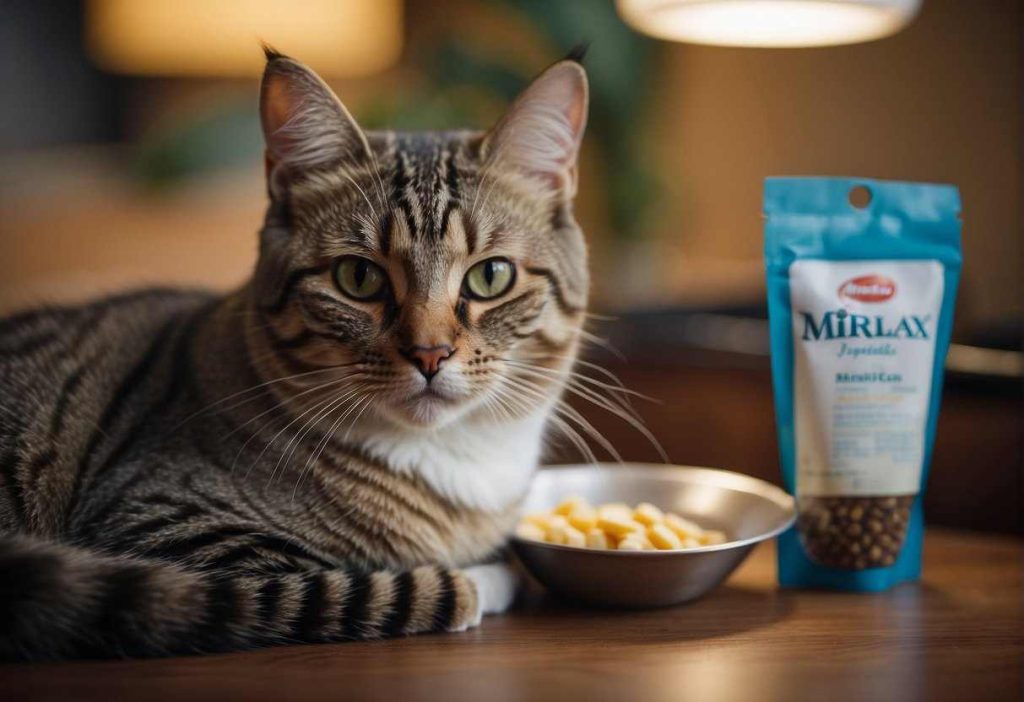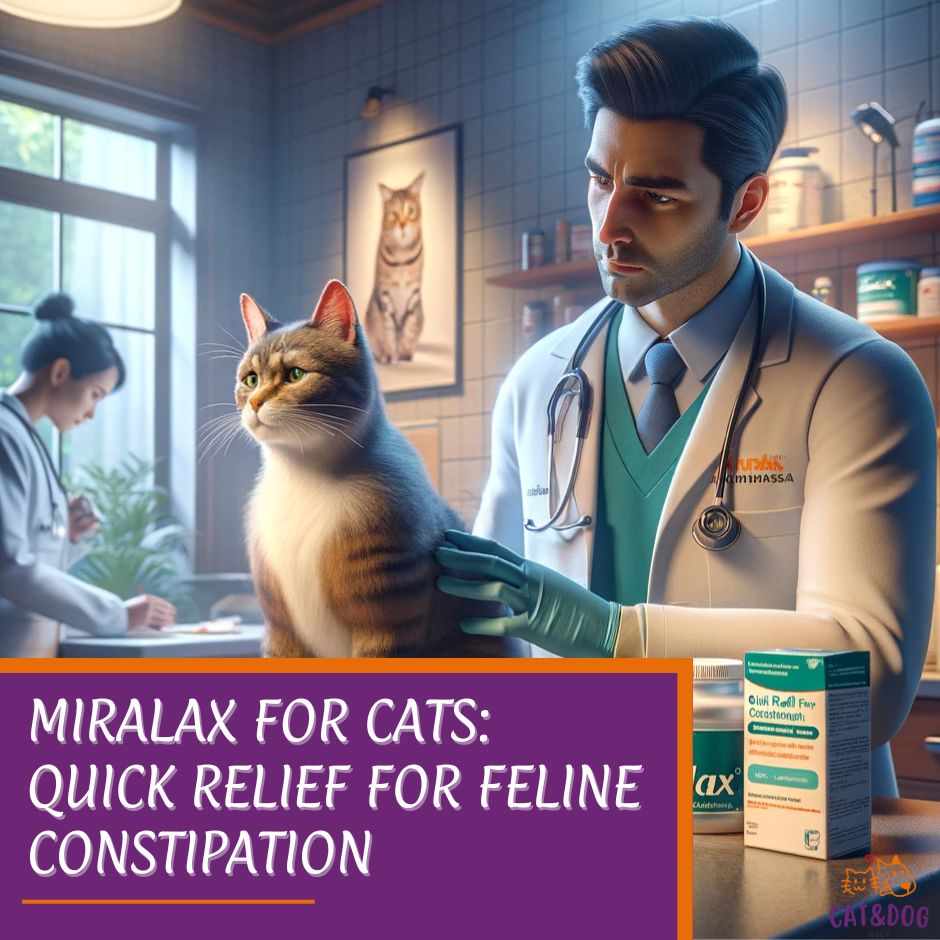One over-the-counter remedy that’s gained attention for helping with constipation is Miralax.
You’ve probably heard of it for humans, but it turns out, we can use Miralax for cats too.
This medication works by drawing water into the intestines, which softens the stool and makes it easier for your cat to have a bowel movement.
Outdoor cats might do poops that you don’t observe and indoor cats might only manage to partly evacuate their bowels during a toilet trip, so that unpassed feces continue accumulating in their bowel, potentially causing an obstruction.
It’s important to intervene early because many cats have one or two episodes of constipation without any further problems, but prolonged constipation can lead to uncomfortable and potentially serious health issues for your indoor cats, requiring enemas and potentially an overnight stay at the vet for treatment.

Miralax is a stool softener, commonly used for cats with constipation, and that is crucial to get the dosage right, so you’ll need to know the active ingredient—polyethylene glycol, also known as lactulose—and understand the mechanism of action for softening feces with this counter laxative. (1)
In some cases, Miralax may also be used as an enema for cats, but it is important to always follow the advice and recommendation of your veterinarian for the safety and well-being of your feline friend, especially if they have constipation issues.
Canned food is often used as a vehicle for administering Miralax to cats, as it can be easily mixed in and is rarely refused by felines.
Okay, but should you be giving it to them? Well, the use of Miralax for cats is generally considered safe when used as directed, but monitoring for side effects is key to keeping your paw-pal healthy.
Before you head to the cupboard, be on the lookout for early signs of constipation: strained defecation, hard stools, or less frequent visits to their throne (the litter box, that is).
Spotting these signs early can help you keep your cat comfy and avoid more serious issues down the line.
However, if your cat has been diagnosed with constipation, it is important to talk with your vet about different treatment options.
Miralax is only safe for short-term use and can cause dehydration and other health concerns if used for a long time or in high doses, including high potassium levels and low sodium levels.
The best treatment for constipation is to try to determine the underlying cause, which generally requires lab tests and X-rays at a minimum.
Key Takeaways
- Miralax can be safely used for treating constipation in cats.
- Proper dosage and close monitoring for side effects are essential.
- Early detection of constipation in cats can prevent serious health problems.
Safety and Efficacy of Miralax For Cats
Cats, like us, can face occasional constipation, and it’s our responsibility to ensure their comfort and health. Let’s chat about Miralax’s role in feline health!
When it comes to safety, vet advice is key. Generally, Miralax is considered safe for cats when used appropriately.
The main ingredient, polyethylene glycol, also known as PEG 3350 or commonly referred to as colyte, works by drawing water into the colon, softening stools, and making them easier to pass. (2)
However, caution is advised, especially in cats with kidney disease or dehydration. It’s always best to check in with your vet before giving it a go.
Benefits of Miralax:
- It addresses constipation effectively.
- Compared to other feline laxatives, it’s milder with fewer side effects.
- Comes in an easy-to-dose powder form.
Remember, each kitty is unique! Some may experience side effects like diarrhea or flatulence.
How does Miralax stack up against other laxatives?
- It’s available with or without a prescription, which is handy.
- Miralax isn’t FDA-approved for pets, but it is widely used off-label.
Ensure you’re giving your cat the comfortable life they deserve! Proper dosing is crucial. Too much of a good thing, or the wrong application, can lead to negative outcomes.
Beyond addressing constipation, comprehensive cat pain management should also consider the discomfort associated with this condition, ensuring treatments like Miralax are part of a holistic approach to your cat’s health
Lastly, while rare, be mindful of signs of toxicity, such as unusual neurologic symptoms. If anything seems amiss, it’s vet time, pronto!
Keep this guide handy and remember, when in doubt, reach out—your vet’s insight is invaluable. With the right care, Miralax can be a safe part of managing your furry pal’s digestive health.
Administering Miralax to Your Cat

When it’s time to give your cat Miralax, simply mix their recommended dose (based on your vet’s recommendation) into their favorite wet food with a lot of water.
This method of administering Miralax to cats is both effective and convenient for pet owners, as it can be mixed with a lot of water to ensure proper hydration.
However, it is important to note that the dosage chart below is a general guide and does not replace your vet’s recommendations.
Recommended Dosage: It’s always best to start by asking your veterinarian for the perfect dosage for your kitty.
Typically, you’d be looking within the range of 1/8 to 1/4 teaspoon mixed into their food, depending on their specific needs.
Step-by-Step Guide:
- Obtain the vet-recommended dose of Miralax powder.
- Mix the Miralax with a small portion of your cat’s wet food to ensure they consume it all.
- Monitor your cat to make sure they eat the food containing Miralax.
Mixing Miralax with Food: Mixing the powder with wet food is the easiest method. Most cats don’t notice the addition, especially since Miralax is tasteless.
Table of Tips for Administration:
| Tip | Explanation |
| Start Slow | Begin with the smallest recommended dose. |
| Consistency | Administer Miralax at the same time daily. |
| Watchfulness | Observe your cat’s response and stool consistency. |
Ensuring Hydration: Water plays a crucial role in preventing and treating constipation. Make sure your cat always has fresh water available. (3)
Proper hydration enables Miralax to work more effectively and promotes overall digestive health.
Got it? Great! You’re now equipped to help your cat through those tough times. Remember, a little care goes a long way – and always keep that water bowl full!
Understanding and Managing Side Effects

Let’s understand and manage these potential side effects, including cat’s constipation, by addressing the underlying cause, to keep our cats happy and healthy, okay?
Severe constipation can lead to an irreversible enlargement of the colon, called idiopathic megacolon, which requires urgent veterinary care.
Common Side Effects of Miralax in Cats
- Soft Stools: A bit of a ‘pudding-pop’ scenario.
- Diarrhea: More like a ‘chocolate fountain’ event—messy, but mostly not serious.
- Flatulence: Yep, your kitty can toot. May clear a room but isn’t generally harmful.
- Dehydration: When they’re losing too much fluid, so keep that water bowl full!
Identifying and Managing Minor Side Effects
- Occasional soft stools or a bit of gas can happen. Check for dehydration by pinching the skin; if it doesn’t snap back quickly, water intake should be increased.
- If diarrhea occurs, consider reducing Miralax dosage—after a quick vet chat, of course!
When to Seek Veterinary Help
You’re a super pet parent for catching those signs early, but when should you actually worry?
- Persistent Diarrhea: More than a couple of days and we’re in the ‘red zone’. (4)
- Vomiting and Weakness: Definitely not normal. Vet time!
- Megacolon: Some research shows two-thirds of constipated cats may have this. Vet discussions are a must. (5)
Remember, your vet is your go-to for managing doses and addressing more serious concerns. With a little vigilance and lots of love, your purring pal will be back on track in no time!
Keep an eye on them, and together, we’ll keep them strutting happily ever after.
Real Cat Owner Experiences

You’re not alone, and thankfully, many cat owners have found Miralax to be a helpful ally in fighting feline constipation and arthritis.
But don’t take our word for it; let’s peek into the real-life experiences of those who’ve been there, tried that, and cuddled their old cat!
Tabby Triumph:
Lola’s Story
- Age: 7 years
- Issue: Chronic constipation
- Result: Smooth “trips” after 2 days of Miralax
Nothing’s worse than seeing your senior tabby struggling. Lola’s human started mixing a vet-recommended dose of Miralax into her water, and voila, Lola was back to her sprightly self in just 48 hours.
Persian Purr-spectives:
Gizmo’s Tail
- Age: 4 years
- Complication: Hairballs leading to constipation
- Outcome: Reduced straining with daily Miralax
Hairballs definitely come with the territory for those luscious locks that Persians sport.
Gizmo’s owner found that a pinch of Miralax not only eased his discomfort but also made him a happier, purrier furball around the clock.
Table: Snapshot of Furry Testimonials
| Fur Parent | Cat’s Name | Age | Symptoms | Miralax Regime | Satisfaction Score |
| Ashley | Pumpkin | 9 | Lethargy | Once daily | 8/10 |
| Mike | Whiskers | 2 | Hard stools | Thrice weekly | 7/10 |
| Ella | Sassy | 5 | Straining | As needed | 9/10 |
Isn’t it reassuring to see such positive outcomes? Plus, these tales highlight how varied the dosage can be, tailor-fitted to each kitty’s needs and lifestyle.
Remember, while these stories are heartwarming and encouraging, always consult your vet for tailored advice, because your feline’s health is unique and precious!
Preventive Measures and Alternative Treatments

Diet and Hydration
Firstly, are you making sure your whiskered companion is getting enough fiber? Just like in humans, fiber can keep things moving smoothly in your cat’s digestive tract. (6)
- High-Fiber Foods: Consider foods with added pumpkin or beet pulp. (7)
- Hydration: Keep that water bowl full! A splash of water in their food, or even using wet food, can help.
Keep ‘Em Moving
Physical activity isn’t just good for keeping your cat in tip-top shape, it can also prevent constipation! Encourage playtime with toys, laser pointers, or even a cardboard box—they’re not fussy.
Alternative Treatments
Not all cats are on board with the Miralax train. Here’s a list of options that could serve as a lifeline:
- Probiotics: These can be a gut’s best friend, supporting a healthy digestive system.
- Herbs: Slippery elm bark is a natural remedy to ease digestive distress.
- Acupuncture: Yes, for cats! It can help with a multitude of issues, including digestion.
Table 1: Preventive Measures
| Prevention Tip | How It Helps |
| High-Fiber Food | Boosts digestion |
| Adequate Hydration | Keeps stool soft |
| Regular Exercise | Stimulates bowel movement |
| Probiotics | Balances gut flora |
| Natural Herbs | Aides digestive comfort |
| Acupuncture | Supports overall well-being |
Remember, before you try any new treatment or make a change to your cat’s routine, it’s best to have a vet give you the green light. They’ll help you tailor an approach that’s purr-fect for your particular pet!
And while statistics and case studies are sparse in this particular area, the age-old wisdom of preventive care remains valid—better safe than sorry, right?
Quick Recap
Let’s give you a speedy lowdown on Miralax for your feline friends!
Key Takeaways on Using Miralax for Cats:
- Miralax isn’t just for humans! It’s commonly used to soften stools in cats facing constipation.
- Its active ingredient, polyethylene glycol 3350 (PEG 3350), works as an osmotic laxative, drawing water into the intestines.
How to Administer:
- Generally mixed with water or food.
- Your vet will tell you the right dose – don’t go it alone!
Monitoring is Key:
- Watch for changes in bowel movements.
- Stay alert to possible side effects.
Final Expert Recommendations:
- Always consult your vet before starting Miralax; each kitty is unique.
- Over-the-counter doesn’t mean over-the-caution; your cat’s safety comes first.
Veterinary Check-in: Have a chat with your vet, because guess what? They are the experts, and they know your furball inside and out.
Remember, administering Miralax is a breeze when done correctly. As caring pet parents, keeping our cats comfortable is the ultimate goal, right? Here’s to happy, healthy cats and no bathroom woes!
Frequently Asked Questions

When it comes to your feline friend’s health, you’ve got questions, and we’ve got answers. Miralax, a common remedy for constipation in cats, can be a little perplexing.
Let’s ease that furrowed brow with some quick insights.
Is Miralax safe for all cats, including kittens and seniors?
Miralax is generally safe for cats when used as directed, but it’s vital to consult your vet, especially for very young kittens or senior cats with additional health concerns.
How quickly does Miralax work in cats?
Typically, Miralax should start to work within 24 to 48 hours. If your cat doesn’t find relief within this timeframe, it’s important to check back with your vet.
Can Miralax be used alongside other medications my cat is taking?
It’s possible, but some medications could interact with Miralax. Always give your vet a full rundown of your cat’s medications before starting anything new.
What are the signs that my cat might be constipated?
Keep an eye out for less frequent bowel movements, straining in the litter box, hard stool, or if your cat is acting lethargic or has a decreased appetite.
How can I prevent constipation in my cat, beyond using Miralax?
Hydration is key – ensure fresh water is always available. A high-fiber diet and regular exercise also work wonders in keeping your kitty regular.
What should I do if my cat refuses to eat food mixed with Miralax?
Some cats may turn their noses up at Miralax. If yours does, try mixing it into a small amount of their favorite wet food as a tasty treat.
Are there any natural alternatives to Miralax for treating cat constipation?
Indeed, pumpkin or wheat bran can add beneficial fiber to your cat’s diet. However, it’s always wise to get a thumbs up from your vet before trying new treatments.


